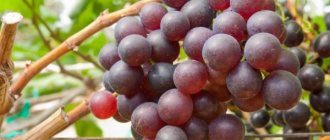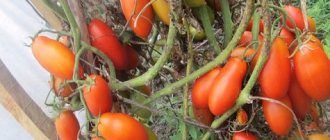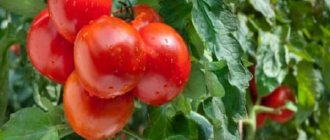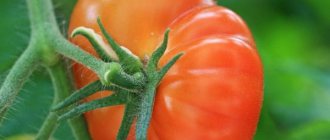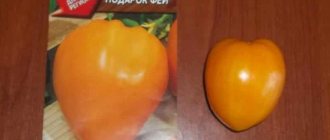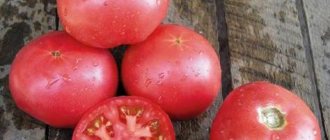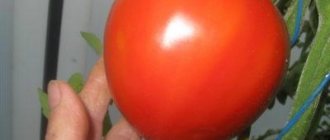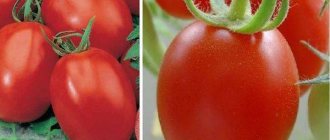Vegetable growing » Tomatoes
0
1566
Article rating
Kira Stoletova
Among the huge variety of tomato varieties, one stands out, which has deservedly received the status of one of the most delicious tomatoes grown in garden beds throughout the country. Tomato Grandmother's Gift must be grown at least once on your own plot in order to understand why gardeners speak so well of it.
Characteristics of tomatoes variety Babushkin Podarok
This variety was bred relatively recently and combines all the good qualities of its parent varieties. Once having tasted Babushkin Podarok tomatoes, more than one summer resident will not resist the temptation to grow these red-sided vegetables in their garden.
general information
As you can see, the name has an “F1” mark, which means that the tomato is a hybrid. As a rule, such vegetables have great endurance and excellent yield. And if we talk about tomatoes “Grandma’s Gift F1”, then this is really true. They were brought out not so long ago - in 2010, during which time tomatoes became very popular. They have decent performance. The hybrid belongs to LLC Research Institute of Vegetable Growing of Protected Soil and LLC Agrosemgavrish. Tomatoes are grown only indoors.
Transplanting seedlings into a greenhouse or open ground
Southern, southwestern and southeastern areas are suitable for planting tomatoes. An area along a southern fence or wall would also be suitable.
Tomatoes are favorable to zucchini, cucumbers, cabbage, onions that grew before them, but it is not recommended to plant them after peppers, potatoes, eggplants and physalis - they have common pathogens. Planting can be repeated after three years.
You need to start preparing the soil for tomatoes in the fall. To do this, the area is dug up, organic matter (10 liters per 1 m²) and superphosphate (40-60 g per 1 m²) are added. If the soil is acidic, then you can add 0.5-0.9 kg of lime per 1 m².
In the spring, it is enough to loosen the soil, adding superphosphate (30-40g) and potash fertilizers (25-30g) for every 1 m². Immediately before planting, add potassium fertilizer (20g) and nitrogen fertilizer (30-40g) per 1 m² to the soil.
Transplanting seedlings:
- can be replanted in soil heated to 12°-15° in the absence of a threat of frost (the ground warms up well under a black film, roofing material);
- Planting should be carried out in furrows or holes at a distance of 30-40 cm between bushes and row spacing of 30-50 cm;
- Fill the holes well with water and wait for the moisture to be absorbed;
- It is recommended to remove the lower leaves from the bush, deepen the trunk by a third, and deepen the tall trunk by half, sloping it to the northwest;
- Sprinkle the roots in a straightened form with earth, lightly crush it, pour with warm water;
- At the same time, you need to install pegs for tying, so as not to damage the roots later;
- During 7-10 days of planting, do not water, loosen or hill up, giving them the opportunity to take root well.
READ MORE: Nepalese cinquefoil description of varieties, cultivation, application in landscape design
For early planting of seedlings, you can use steam beds: a trench 60 cm wide and 20 cm deep is filled with heated manure (5 cm) and covered with earth (15 cm).
On a note! Planting on such ridges is carried out 20 days earlier.
Characteristics and description
- Tall hybrid - up to 2 meters, requiring garter. Does not form a standard.
- The root system is very powerful.
- The trunk has pubescence, the leaves are green and wrinkled.
- Indeterminate type. Shaping and pinching is required.
- Large-fruited - up to 300 grams.
- The shape of the fruit is round and slightly flattened.
- The color of the skin is scarlet, it is thin but dense. There is a slight ribbing on the tomatoes.
- It belongs to the mid-late varieties - 120-125 days pass before harvest.
- Can be used for fresh and winter salads, very tasty juice, paste, ketchup made from “Granny’s Gift F1” tomatoes.
- Productive - you can get up to 6 kg from one bush.
- It is grown only in warm greenhouses or ordinary ones made of polycarbonate.
This is what a “gift” is. The indicators are really good, but we will also tell you further whether the tomato has any disadvantages.
Always read the manufacturer's packaging information. Each variety or hybrid has its own agricultural technology. Also consider regional cultivation.
Reviews
I grew the variety “Grandma’s Gift F1” in a greenhouse. She led the bushes into one trunk. By the way, I grow all the tall trees into one trunk, since caring for them is much easier, and the yield is still good. The plants of Grandmother's Gift are very strong and powerful. The trunk is well overgrown with foliage and beautiful tassels. Knits well. Even in the heat there were a lot of ovaries. The fruits are beautiful, round in shape. Ideal for whole-fruit canning. But I was not impressed by the taste, very mediocre for me. The ripening of fruits in the variety is uneven, fruiting is extended. 5-7 fruits are formed in the brush. The bushes are very tall; they grew up to two meters tall for me. Overall the variety is good.
Just a wonderful variety with such a kind and sweet name Grandma’s Gift. I have been growing it for several years now, and I have already learned all the nuances associated with growing these tomatoes. In our North, it is, of course, better to grow tomatoes in a greenhouse. I plant seedlings in the garden in the last days of May. The bushes begin to bear fruit by the end of July. They love feeding very much. The plants are tall, growing up to 180 centimeters. I use a trellis for garter. There are not very many fruits on the bush. Each brush carries up to 8 tomatoes. The tomatoes are all equal in size and weight. The taste is juicy, meaty, sweetish. But, to be honest, all hybrids do not have as pronounced a taste as varietal tomatoes. But, if we take into account all the positive aspects of this variety, then “Grandma’s Gift” is an excellent option for growing. The bushes almost never get sick, they knit well, produce a lot of beautiful fruits that can be eaten fresh or used for various pickles.
Good standard variety. Nothing particularly stands out. As befits hydrides, tomatoes withstand the vagaries of weather; the trunks of the bushes are strong and hold up well. They grow two meters tall. But I don’t even pinch the top, it doesn’t bother anyone. The harvest has time to fully ripen before the onset of cold weather. The taste is good, but there are sweeter tomatoes.
Among the huge variety of tomato varieties, one stands out, which has deservedly received the status of one of the most delicious tomatoes grown in garden beds throughout the country. Tomato Grandmother's Gift must be grown at least once on your own plot in order to understand why gardeners speak so well of it.
Characteristics of tomatoes variety Babushkin Podarok
This variety was bred relatively recently and combines all the good qualities of its parent varieties. Once having tasted Babushkin Podarok tomatoes, more than one summer resident will not resist the temptation to grow these red-sided vegetables in their garden.
Advantages and disadvantages
From the characteristics and description of the tomato variety “Grandma’s Gift F1” you realized that the hybrid has many strengths, but it has some disadvantages. Pay attention to them.
Advantages of the variety:
- sustainability;
- tasty and juicy fruits, with a slight sourness;
- transportability, but only over short distances;
- large tomatoes and high yield.
Disadvantages of the variety:
- the crop is not stored for long;
- the variety cannot be grown outdoors;
- hybrids do not produce productive seeds;
- long growing season;
- Tomatoes require attention during cultivation.
As you can see, the hybrid has both advantages and disadvantages. In general, tomatoes will provide the opportunity to obtain a good harvest, which can be eaten fresh even in the fall, and you can also stock up.
Diseases
The hybrid “Grandma’s Gift” has a high susceptibility to diseases such as tobacco mosaic virus, blackleg, fruit cracking, bacteriosis, and Alternaria blight. But quite often it is affected by such an unpleasant and incurable disease as late blight. It is believed to be one of the most common diseases among vegetable crops and develops in humid and excessively warm environments. Spores that are in the soil or on seedlings in such a “greenhouse” climate germinate, multiply quickly and contribute to the damage to all parts of the tomato plant, including the fruits themselves.
Identified affected plants must be immediately removed from the garden bed, otherwise late blight will spread to all healthy plantings. Fruits from diseased plants should not be eaten.
But it is better to combat late blight using prevention, preventing its development. To prevent plants from getting sick with such a dangerous disease, you need to carry out pinching regularly and not thicken the plantings. This is all done to ensure that the bushes are well ventilated and that excess moisture does not accumulate in the beds. Watering must also be timely. The greenhouse must be regularly ventilated and the plants must be provided with plenty of sunlight.
Features of growing the variety
Sowing of late tomatoes begins earlier - approximately from the second ten days of February. But it should immediately be noted that the seedlings will need additional lighting. You don’t have to pickle the seeds, but for better germination, soak them in Epin for 24 hours. Then dry it. Prepare your own soil or purchase it. You can make a composition from equal parts of humus, soil from the garden, peat and superphosphate - according to the instructions for your volume of soil. Afterwards it is poured with boiling water, dried and the seeds are sown.
The seeds are buried 2 cm, moistened, and covered with film. The temperature is needed high for germination. In the phase of 1-2 true leaves, tomato seedlings “Grandma’s Gift F1” are planted in separate cups. After two weeks, they are flushed with nitrogen. You need to monitor the lighting all the time - seedlings need light up to 14 hours a day.
Tomato care
After the seedlings have taken root, surface loosening of the soil and the first hilling are carried out. Loosening is carried out as a crust forms on the surface of the earth, hilling - 3-4 times per season. These measures allow the roots to breathe and improve the delivery of nutrients.
You may be interested in: Dates for planting tomato seedlings in open ground and greenhouses according to the garden calendar Favorable days for planting tomatoes for seedlings in 2021 according to the lunar sowing calendar Favorable days for picking tomatoes in 2021 after germination: timing of picking tomato seedlings in the table by day
At the same time, perform the first tying of the bush to a support (trellis, peg). Carry out the garter 2-3 times during the season.
Important! Hilling should be carried out after rain or after watering - damp soil will accelerate the growth of new roots.
Watering is carried out at the root, adding 0.7-0.9 liters to each bush. The best time to water is early morning or evening. During the flowering period of the first and second clusters, watering is required.
At high outside temperatures, the greenhouse should be ventilated so that fresh air circulates - high humidity and heat contribute to the development of late blight.
Once a week you need to remove side shoots that have reached 3-5 cm, leaving a small stump - then a new shoot will not grow in this place.
Feeding tomatoes
10-12 days after planting, carry out the first fertilizing by preparing a mixture: add superphosphate (20g) to 10 liters of mullein solution (1 part manure and 8-9 parts water). Use this volume for 10 bushes.
The next two feedings are carried out at intervals of 2 weeks after loosening or before hilling using mineral fertilizers - add superphosphate (20g), potassium salt (15g) and ammonium nitrate (10g) per 1 m².
Signs of nutritional deficiencies
By changes in the appearance of a tomato bush, one can judge the lack of a particular substance in the soil:
- lack of nitrogen - the color of leaves and fruits changes, the leaves become small, red-blue veins appear on the bottom, and the fruits harden;
- lack of phosphorus - leaves begin to curl inward;
- lack of potassium is manifested by leaf curl;
- the appearance of yellow spots on young leaves, a change in the color of old leaves to dark green indicates a lack of calcium;
- fragility and brittleness of the stems, first pale green leaves, and then their yellowing or redness indicate a lack of sulfur;
- Brown spots on the fruit indicate a lack of boron;
- Tomato bushes stop growing, young leaves are affected by chlorosis due to iron deficiency.
Eating tomatoes
Babushkino tomatoes can be prepared in many ways, for fresh consumption and for winter preparations.
- They are delicious in fresh green salads.
- You can make fresh juices, or you can use them for canning.
- Vegetable purees for winter preparations are good.
- Ketchups and adjikas taste like sweet honey.
- The main thing is to harvest the crop on time, and only then begin processing.
- Overripe tomatoes lose their unique flavor notes, including their unique aroma.

